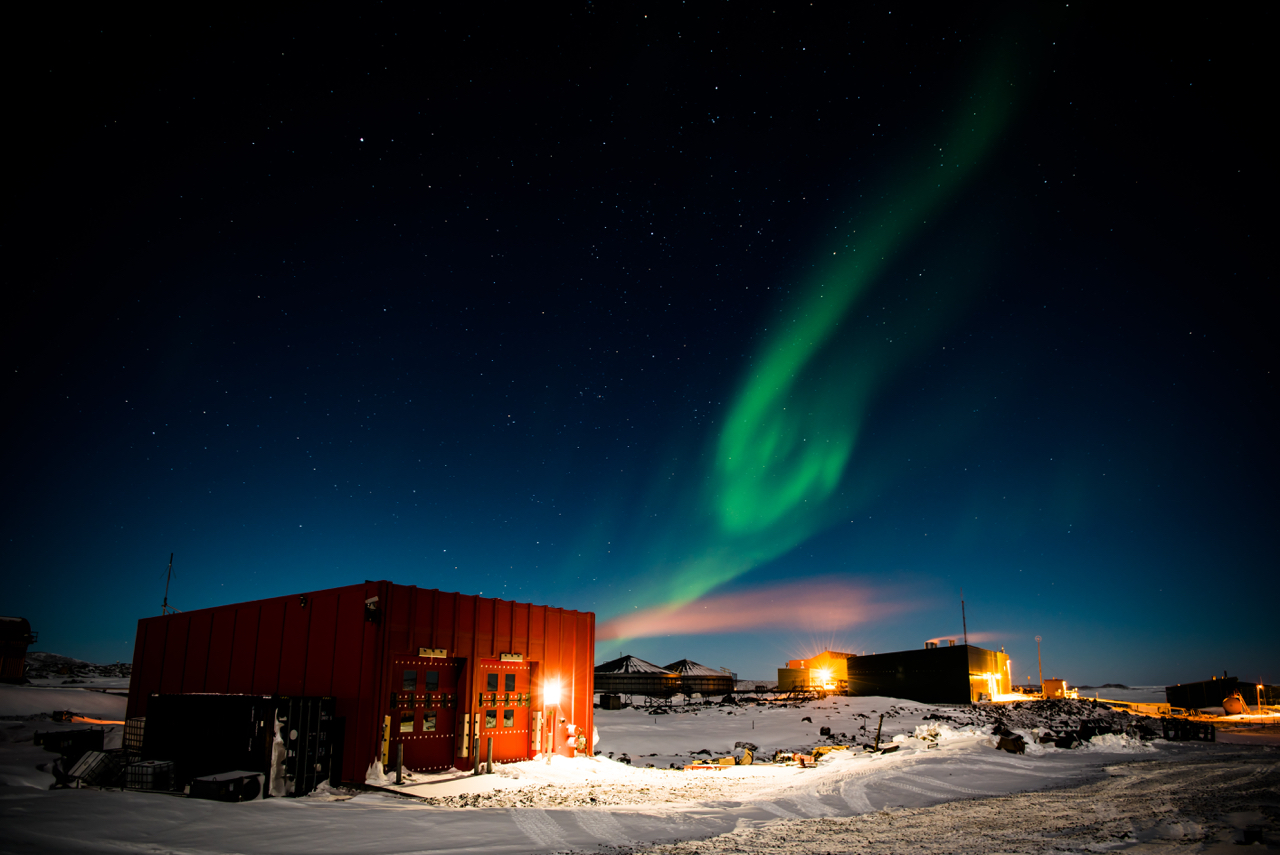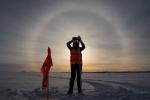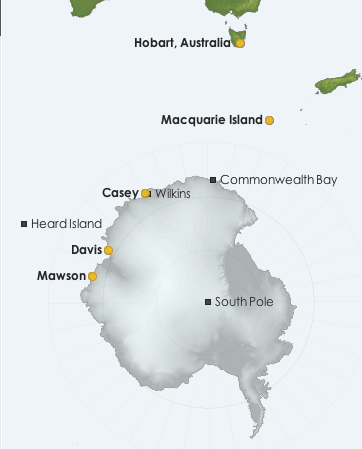Frozen forecasts: meteorology in Antarctica
01 December 2017
Updated 27 November 2024
You probably know the Bureau's weather services cover Australia, but did you know our reach stretches further south – nearly as far south as you can go – to Antarctica? So what is the weather really like down there, why does it matter and just what are we doing there?
From the days when Griffith Taylor (an ex-Bureau officer) represented the 'weather service' on Scott's Terra Nova Expedition from 1910–13, the Bureau has had a connection to the important weather and climate work done in Antarctica. However, our ongoing history with Antarctica and the Australian Antarctic Program began with the establishment of the first Antarctic and sub-Antarctic research stations more than 70 years ago.

Image: An AAD staff member drills sea ice to measure its thickness. Credit: Barry Becker
Who’s in Antarctica – and why?
Around 17 Bureau staff – technical officers and meteorologists – work across the 4 Australian stations: Casey, Mawson, Davis, and Macquarie Island. Meteorologists help with aviation operations such as resupply trips, and research and transport flights. They also provide forecasts for each of the research stations, field camps and Southern Ocean. Our staff's work also contributes to services for the mainland. Data collected supports marine and atmospheric weather services, and even space weather, which can affect satellite systems and communications.

Image: A Royal Australian Air Force plane drops fresh food, medical supplies and mail to expeditioners at Davis station. Credit: Barry Becker
Our staff are spread across the research stations:
- Mawson – 2 technical officers
- Davis – 3 technical officers and 2 meteorologists
- Casey – 3 technical officers and 3 meteorologists
- Macquarie Island – 3 technical officers.
On top of this, one or two people are assigned to assist with project work and a meteorologist often joins the crew of the RSV Nuyina as it makes resupply trips to Macquarie Island.
The technical staff cover winter as part of a 12-month placement and the meteorologists cover summer for around 5 months.
What's the weather like?
No surprises here; it’s nippy. And gusty—but it varies depending on where you are.
Mawson
Mawson is at the bottom of a steep escarpment on the edge of the Antarctic Plateau, with a climate dominated by cold ‘katabatic’ winds, streaming downslope through the effects of gravity. On average Mawson has the highest wind speed of all the Bureau's monitoring sites. With an average annual wind speed of 39 km/h, speeds are twice as high here as in Melbourne; 3 times higher than Darwin, Sydney or Hobart; and 4 to 5 times higher than Brisbane, Adelaide or Perth. The average maximum temperature here is -8.3 °C, while the average minimum is -14.2 °C.
Davis
Davis is in an ice-free area known as the Vestfold Hills, a popular hiking area for staff in their time off and a key factor in the local climate. Davis is the warmer summer location and is affectionately known as the ‘Riviera of the south’ because the bare rocks of the Vestfold Hills heat up substantially under the 24-hour summer sun. The average November to March maximum is a relatively balmy -0.5 °C, with the warmest temperature recorded for the same period being 13 °C! Davis also holds the record for the coldest temperature recorded at an Australian station, a seriously chilled -41.8 °C.
Casey
Next is Casey, just outside of the Antarctic Circle with recorded temperatures ranging from
–37 °C to 9 °C. The wind usually blows at a gentle 20 km/h, but recordings of wind gusts have measured an impressive 241 km/h. Even cooler (if daylight’s not your thing)—during the start of winter the station sees sunshine for less than an hour a day.
Macquarie Island
The last station is on an isolated speck of rock in the middle of the Southern Ocean – Macquarie Island (also known as ‘Macca’). Located in the 'furious fifties' latitude belt between Australia and Antarctica, the weather is warmer due to the influence of the surrounding water, but the island is buffeted by frequent gales and rain or snow showers. In fact it rains on average 316 days every year. Mean maximum temperatures range from 5–9 °C and hit as low as -9 °C in the winter months.
Map: Antarctica showing the research stations where Bureau staff are located.
Credit: AAD
Working with the Australian Antarctic Division
We work closely with the Australian Antarctic Division (AAD), the Australian Government division responsible for managing Australia’s presence on the continent, and conducting scientific research in Antarctica. This partnership sees us provide essential services in alignment with the Government's wider Antarctic vision.
One of the best ways we support the AAD is by placing our meteorologists in the field. Their first-hand knowledge of the local environment allows them to understand just how serious the weather can be. Ever try finding a ship that has magically disappeared into the fog? You've got to see it to believe it.

Image: The aurora australis over Davis Station in September 2017. Credit Barry Becker
How 'cool' is it working in Antarctica?
It's pretty cool indeed – in both senses of the word! The Bureau recruits for assignments lasting up to 16 months. This is a training and preparation period of 4 to 6 months in Melbourne and Hobart before a 6 to 12 month placement in Antarctica.
You’ll find information on our Antarctic recruitment program and current opportunities here.
The AAD also recruits for a range of roles in Antarctica.
More information
Life on the ice: forecasting in Antarctica




Comment. Tell us what you think of this article.
Share. Tell others.